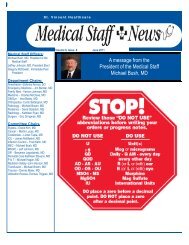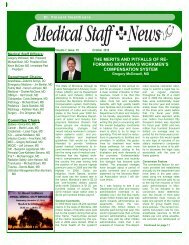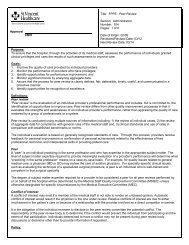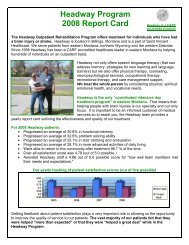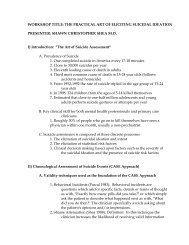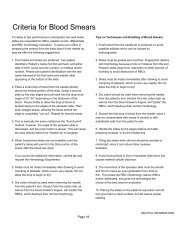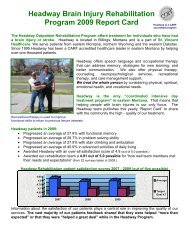AHA/ASA Guideline Guidelines for the Prevention of Stroke in ...
AHA/ASA Guideline Guidelines for the Prevention of Stroke in ...
AHA/ASA Guideline Guidelines for the Prevention of Stroke in ...
You also want an ePaper? Increase the reach of your titles
YUMPU automatically turns print PDFs into web optimized ePapers that Google loves.
256 <strong>Stroke</strong> January 2011hemoglob<strong>in</strong>, hydroxyurea, or bypass surgery <strong>in</strong>cases <strong>of</strong> advanced occlusive disease (Class IIb; Level<strong>of</strong> Evidence C) (Table 10).F. Cerebral Venous S<strong>in</strong>us ThrombosisThe estimated annual <strong>in</strong>cidence <strong>of</strong> cerebral venous thrombosis(CVT) is 3 to 4 cases per 1 million population. 448Although CVT accounts <strong>for</strong> 1% <strong>of</strong> all strokes, it is animportant diagnostic consideration because <strong>of</strong> <strong>the</strong> differences<strong>in</strong> its management from that <strong>of</strong> arterial strokes. 448Early anticoagulation is <strong>of</strong>ten considered as both treatmentand early secondary prophylaxis <strong>for</strong> patients with CVT,although controlled trial data rema<strong>in</strong> limited to 2 studies.449,450 The first trial compared dose-adjusted unfractionatedhepar<strong>in</strong> (UFH; partial thromboplast<strong>in</strong> time at least 2times control) with placebo. The study was term<strong>in</strong>ated earlyafter only 20 patients had been enrolled, because <strong>of</strong> <strong>the</strong>superiority <strong>of</strong> hepar<strong>in</strong> <strong>the</strong>rapy (P0.01). Eight <strong>of</strong> <strong>the</strong> 10patients randomly assigned to hepar<strong>in</strong> recovered completely,and <strong>the</strong> o<strong>the</strong>r 2 patients had only mild neurological deficits. In<strong>the</strong> placebo group, only 1 patient had a complete recovery; 3patients died. 449 The same research group also reported aretrospective study <strong>of</strong> 43 patients with cerebral venous s<strong>in</strong>usthrombosis associated with <strong>in</strong>tracranial bleed<strong>in</strong>g; 27 <strong>of</strong> <strong>the</strong>sepatients were treated with dose-adjusted hepar<strong>in</strong>. The mortalityrate <strong>in</strong> <strong>the</strong> hepar<strong>in</strong> group was considerably lower than <strong>in</strong><strong>the</strong> nonanticoagulation group. 449A more recent and slightly larger randomized study <strong>of</strong>cerebral venous s<strong>in</strong>us thrombosis (n59) compared nadropar<strong>in</strong>(90 anti–Xa U/kg twice daily) with placebo. 450 After 3months <strong>of</strong> follow-up, 13% <strong>of</strong> patients <strong>in</strong> <strong>the</strong> anticoagulationgroup and 21% <strong>in</strong> <strong>the</strong> placebo group had poor outcomes(RRR, 38%; PNS). Two patients <strong>in</strong> <strong>the</strong> nadropar<strong>in</strong> groupdied, compared with 4 patients <strong>in</strong> <strong>the</strong> placebo group. Patientswith <strong>in</strong>tracranial bleed<strong>in</strong>g were <strong>in</strong>cluded, and no new symptomaticcerebral hemorrhages occurred <strong>in</strong> ei<strong>the</strong>r group.In a Cochrane meta-analysis <strong>of</strong> <strong>the</strong>se 2 trials, anticoagulant<strong>the</strong>rapy was associated with a pooled relative risk <strong>of</strong> death <strong>of</strong>0.33 (95% CI, 0.08 to 1.21) and death or dependency <strong>of</strong> 0.46(95% CI, 0.16 to 1.31). No new symptomatic ICHs wereobserved <strong>in</strong> ei<strong>the</strong>r study. One major gastro<strong>in</strong>test<strong>in</strong>al hemorrhageoccurred after anticoagulant treatment. Two controlpatients (on placebo) had a diagnosis <strong>of</strong> probable pulmonaryembolism (one fatal). 451 On <strong>the</strong> basis <strong>of</strong> <strong>the</strong>se 2 trials, <strong>the</strong> use<strong>of</strong> anticoagulation with hepar<strong>in</strong> or LMWH given acutely <strong>in</strong><strong>the</strong> sett<strong>in</strong>g <strong>of</strong> CVT is recommended, regardless <strong>of</strong> <strong>the</strong>presence <strong>of</strong> hemorrhagic conversion.No randomized trial data exist to guide duration <strong>of</strong> anticoagulation<strong>the</strong>rapy. For an <strong>in</strong>itial event, periods between 3 and12 months have been reported. Patients with <strong>in</strong>herited thrombophilia<strong>of</strong>ten undergo anticoagulation <strong>for</strong> longer periodsthan someone with a transient (reversible) risk factor such asoral contraceptive use. Given <strong>the</strong> absence <strong>of</strong> data on duration<strong>of</strong> anticoagulation <strong>in</strong> patients with CVT, it is reasonable t<strong>of</strong>ollow <strong>the</strong> externally established guidel<strong>in</strong>es set <strong>for</strong> patientswith extracerebral DVT, which <strong>in</strong>cludes anticoagulationtreatment <strong>for</strong> 3 months <strong>for</strong> first-time DVT <strong>in</strong> patients withtransient risk factors and at least 3 months <strong>for</strong> an unprovokedfirst-time DVT and anticoagulation <strong>for</strong> an <strong>in</strong>def<strong>in</strong>ite period <strong>in</strong>patients with a second unprovoked DVT. 452 Antiplatelet<strong>the</strong>rapy is generally given <strong>in</strong>def<strong>in</strong>itely after discont<strong>in</strong>uation <strong>of</strong>warfar<strong>in</strong>.Given <strong>the</strong> relatively high proportion <strong>of</strong> pregnancy-relatedCVT, which ranges from 15% to 31%, 453 <strong>the</strong> risk <strong>for</strong>recurrent CVT dur<strong>in</strong>g subsequent pregnancies is a commonlyencountered question. Sixty-three pregnancies <strong>in</strong> patientswith prior CVT have been reported <strong>in</strong> <strong>the</strong> literature, <strong>in</strong>clud<strong>in</strong>g21 with pregnancy-related CVT, with normal delivery and norecurrence <strong>of</strong> CVT. Although this suggests that future pregnanciesare not an absolute contra<strong>in</strong>dication, given <strong>the</strong> scarcity<strong>of</strong> available data, decisions about future pregnanciesmust be <strong>in</strong>dividualized. 454Recommendations1. Anticoagulation is probably effective <strong>for</strong> patientswith acute CVT (Class IIa; Level <strong>of</strong> Evidence B).2. In <strong>the</strong> absence <strong>of</strong> trial data to def<strong>in</strong>e <strong>the</strong> optimalduration <strong>of</strong> anticoagulation <strong>for</strong> acute CVT, it isreasonable to adm<strong>in</strong>ister anticoagulation <strong>for</strong> at least3 months, followed by antiplatelet <strong>the</strong>rapy (ClassIIa; Level <strong>of</strong> Evidence C) (Table 10).G. Fabry DiseaseFabry disease is a rare X-l<strong>in</strong>ked <strong>in</strong>herited deficiency <strong>of</strong> <strong>the</strong>lysosomal enzyme -galactosidase, which causes lipid deposition<strong>in</strong> <strong>the</strong> vascular endo<strong>the</strong>lium and results <strong>in</strong> progressivevascular disease <strong>of</strong> <strong>the</strong> bra<strong>in</strong>, heart, sk<strong>in</strong>, and kidneys. 455<strong>Stroke</strong> may occur due to dolichoectasia <strong>of</strong> <strong>the</strong> vertebral andbasilar arteries, cardioembolism, or small-vessel occlusivedisease. 455–457 Fabry disease may be underdiagnosed as acause <strong>of</strong> seem<strong>in</strong>gly cryptogenic stroke <strong>in</strong> <strong>the</strong> young. 458Antiplatelet agents are believed to be useful <strong>in</strong> prevent<strong>in</strong>gischemic events related to exist<strong>in</strong>g vascular disease, 458 but <strong>the</strong>disease itself was untreatable and <strong>the</strong> prognosis quite pooruntil recomb<strong>in</strong>ant -galactosidase A became available. Inrandomized controlled trials, adm<strong>in</strong>istration <strong>of</strong> <strong>in</strong>travenous-galactosidase (also known as agalsidase beta) at a dose <strong>of</strong>1 mg/kg every o<strong>the</strong>r week reduced new and cleared oldmicrovascular endo<strong>the</strong>lial deposits <strong>in</strong> <strong>the</strong> kidneys, heart, andsk<strong>in</strong> 459 and modestly reduced <strong>the</strong> composite <strong>of</strong> renal, cardiac,or cerebrovascular events or death (HR, 0.47; 95% CI, 0.21 to1.03). 460 Enzyme replacement <strong>the</strong>rapy also leads to cl<strong>in</strong>icalimprovements <strong>in</strong> kidney function, 460,461 but <strong>the</strong> impact oncardiac function has been <strong>in</strong>consistent. 462,463 Enzyme replacement<strong>the</strong>rapy has been shown to have a favorable effect oncerebral blood flow, 464 but <strong>the</strong> risk <strong>of</strong> stroke appears substantialdespite <strong>the</strong>rapy. 465 Earlier <strong>in</strong>tervention or higher enzymedoses or both may be needed <strong>for</strong> stroke prevention, and thisis an area <strong>of</strong> active research. 466 The major adverse effects <strong>of</strong>recomb<strong>in</strong>ant -galactosidase A <strong>in</strong>fusions are fever and rigors,which may occur <strong>in</strong> 25% to 50% <strong>of</strong> treated patients but maybe m<strong>in</strong>imized with slow <strong>in</strong>fusion rates and premedicationwith acetam<strong>in</strong>ophen and hydroxyz<strong>in</strong>e. An expert panel recommendedenzyme replacement <strong>the</strong>rapy <strong>for</strong> all male patientsstart<strong>in</strong>g at age 16 and all o<strong>the</strong>r patients if <strong>the</strong>re is evidence <strong>of</strong>symptoms or progressive organ <strong>in</strong>volvement. 467Recommendations1. For patients with ischemic stroke or TIA and Fabrydisease, -galactosidase enzyme replacement <strong>the</strong>r-Downloaded from stroke.ahajournals.org by on March 8, 2011



